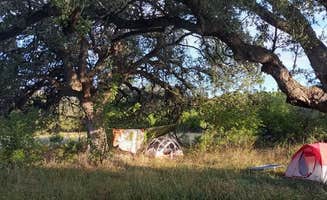Dispersed camping opportunities near Manchaca, Texas center around Lake Georgetown, where several primitive sites provide free camping access. The region experiences hot summers with temperatures frequently exceeding 95°F from June through September, while winter nights can drop below freezing. Trail conditions vary seasonally, with October through April offering the most moderate temperatures for backcountry camping.
What to do
**Wildlife observation: ** The San Gabriel River Trail provides opportunities to spot local wildlife including white-tailed deer, armadillos, and numerous bird species. The trail's varied terrain creates different habitats that attract diverse wildlife. One camper at San Gabriel River Trail notes, "The trail circles Lake Georgetown and is 26.2 miles. It passes through forests, grasslands, over some small hills and across a few tributaries."
**Water access: ** Lake Georgetown offers swimming and fishing opportunities, though water levels fluctuate seasonally. Trail sections provide access points to the water, but these can require off-trail hiking. A visitor to Sawyer Park Primitive Campsites shared, "We ended up not following our AllTrails after a fork in the road heading towards the campsite, and were pretty pooped so decided to camp there off Sawyer Campsite Rd. People had clearly used the shore as a campsite before as there was a makeshift fire pit and some cleared areas for tents. Water and views were beautiful."
**Trail hiking: ** The full loop trail offers challenging sections for day hiking or backpacking trips. The trail system connects multiple camping areas, allowing for different trip configurations. Hikers should note that approximately 60% of the trail has no shade coverage, making summer hiking particularly challenging.
What campers like
**Natural setting: ** The primitive camping areas maintain a natural, undeveloped atmosphere with minimal human infrastructure. Sites often feature established clearings beneath tree cover, particularly at Walnut Springs. A camper at Walnut Springs Primitive Campground described, "Large open area; for fire pits for lamp hangers for picnic tables trees closer the trail and grass sea areas closer to the water."
**Accessibility options: ** Some primitive sites can be reached via shorter hikes, making them more accessible for those with limited time or backpacking experience. "Can be biked in from camp Tejas four miles away or can hiking from Russell Park 2 mi away," notes one visitor to Walnut Springs Primitive Campground.
**Multiple access points: ** The trail system features several trailheads with parking, allowing hikers to plan routes of varying difficulty and duration. This flexibility helps campers customize their experience based on weather conditions and physical abilities.
What you should know
**Weather considerations: ** Summer temperatures combined with limited shade can create challenging hiking conditions. Thunderstorms can occur suddenly, particularly during spring and fall. One camper recalls, "Enjoyed our stay during a thunderstorm under the big trees."
**Water management: ** Surface water requires filtration and treatment before consumption. Campers should carry sufficient water during hikes, especially in summer. "While you may be hiking within site of Lake Georgetown and the water, it is not always convenient to access the water. So be sure to carry plenty of water - at least 2 liters," advises a frequent visitor to San Gabriel River Trail.
**Trail popularity: ** Weekend traffic can increase significantly, particularly near more accessible sites. "The trail is getting more and more popular with backpackers, so it is likely that you may see others on the trail. On weekends you may encounter scout troops practicing backpacking. During the weekdays you may not see a single person," reports one camper.
Tips for camping with families
**Distance planning: ** When camping with children, choose sites closer to trailheads to minimize hiking distances. Walnut Springs offers the shortest access at approximately 2 miles from Russell Park.
**Safety preparation: ** Cell coverage can be unreliable in portions of the trail system. Families should bring appropriate first aid supplies and emergency communication options when venturing into more remote sections of the trail.
**Educational opportunities: ** The trail system presents opportunities to teach children about local ecosystems and Leave No Trace principles. Pack field guides for identifying plants and animals common to central Texas oak savanna and riparian environments.
Tips from RVers
**Parking limitations: ** RV parking at trailheads is limited, with some access points providing only standard vehicle spaces. Larger rigs may need to park at developed campgrounds and hike from there to access the free camping areas.
**Supply planning: ** Since these are primitive sites requiring hiking access, RVers should plan for transferring camping supplies from vehicle to backpack. Many RVers use these sites as an opportunity to experience tent camping while leaving their RV at a developed campground.
**Alternative options: ** For those seeking free camping with RV access near Manchaca, consider BLM lands farther west or national forest dispersed camping areas in East Texas, as the Lake Georgetown sites are exclusively hike-in.


